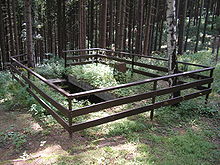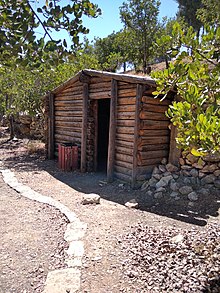Zemlyanka
| Zemlyanka | |
| Russian | землянка |
|---|---|
| Romanization | zemlyánka |
| Literal meaning | “earth-thing” |
Zemlyanka (Russian or Ukrainian: Землянка, Polish: ziemianka) is an Eastern Slavic name for a dugout or earth-house which was used to provide shelter for humans or domestic animals. Based on a hole or depression dug into the ground, these structures are one of the most ancient types of housing known. Zemlyankas can be partially or fully recessed into the earth, with a flat roof covered with branches or sod, or dug into a hillside. The use of natural earth for insulation and protection for underground living has evolved into the "earth shelter" technology used today in architecture.
World War II[]


In World War II, partisans, or armed resistance fighters in Eastern Europe sometimes lived in zemlyankas which were used as underground bunkers to provide shelter and a hiding place from enemies. Notably they were used by members of the famous "Bielski partisans" in modern-day Belarus.[1] In Poland they were called ziemianki.
In popular culture[]
Zemlyanka was the name of an Eastern Front (World War II) song written by A. Surkov (lyrics) and K. Listov (music) in 1941 during the Battle of Moscow.[2] The use of zemlyankas by soldiers is mentioned in the song. However, due to its pessimism, the song was considered to be unpatriotic by the Soviet government at the time.
See also[]
References[]
| Wikimedia Commons has media related to Dugouts (shelter). |
- ^ "Virtual Zemlyanka". Jewish Partisan Educational Foundation. Archived from the original on 2007-09-28.
- ^ Zemlyanka.mp3— by Community Music Project; from the album Dreams of Flying; vocal & guitar: Jamuna; guitar & bass: Paul
- Belarus in World War II
- Subterranea (geography)
- House types
- Semi-subterranean structures
- Russia stubs
